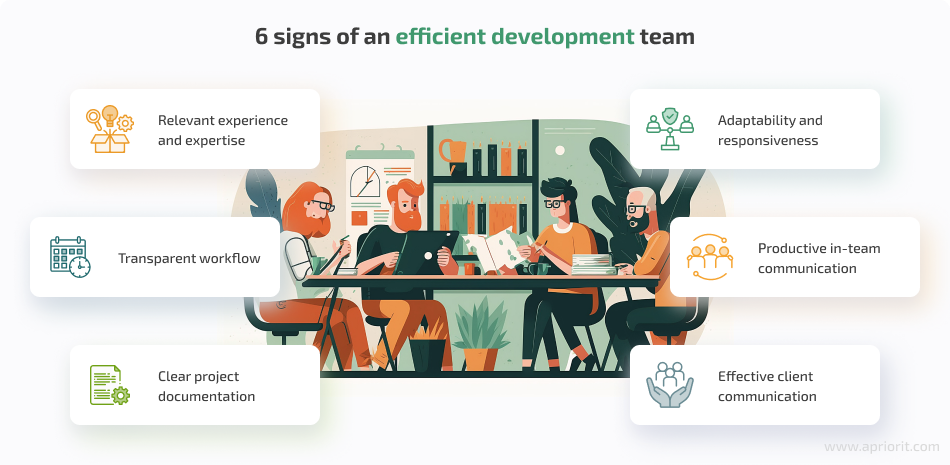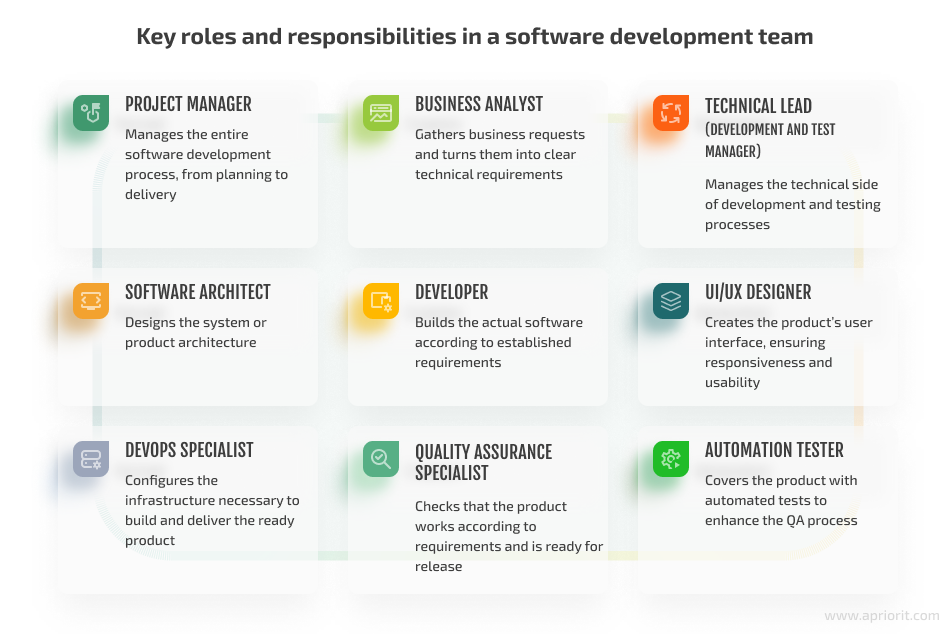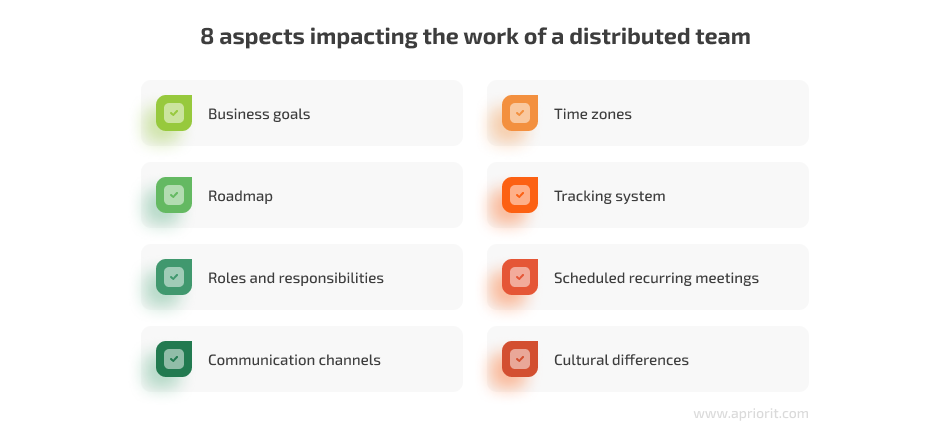Software development management is a complex process. To deliver a quality product, you need to gather and organize the work of field experts and rare talents, which are sometimes hard to find in the same place. That’s why businesses often go with distributed development teams.
A distributed team, in which members work from different cities, countries, and even continents, brings both benefits and challenges. As a global outsourcing software development company with 20+ years on the market, Apriorit has valuable insights on managing such teams.
In this article, we discuss how to gather a team of relevant experts who are well equipped to deliver the required results within the expected timeframes. This article will be useful for technical and project leaders looking for ways to optimize their workflows.
Contents:
Basic structure of a software development team
While software development team organizational structure depends on the specifics of a particular project, such a team usually has to tackle the following tasks:
- Conduct market research
- Plan, design, and build the actual product
- Establish efficient communication with stakeholders
- Ensure that the end product is beneficial for the business
- Control product quality
- Simplify user and product workflows
- And more
It’s also crucial for the project team to work towards a common goal — to design and deliver on time a product that meets business requirements. The team should function as a unified mechanism, in which team members understand each other and stay focused on common results.
It’s highly unlikely you can achieve this when you work not with a unified team but with a group of individual freelance developers. While specialists hired separately to accomplish specific tasks may be true experts in their fields, they often lack teamwork skills, making it difficult for them to efficiently collaborate with other freelancers. Thus, you’ll have to spend extra time yourself or hire separate personnel for managing software development by freelancers, establishing communication channels, and continually monitoring progress and deadlines.
Consider hiring an outsourced team?
Entrust your software development to Apriorit and receive a professionally-coordinated team with all the skills and experience matching your project needs.
A professional software development team is client-oriented and focused on achieving the client’s goals. Each team member is dedicated to their specific role while understanding the overall purpose, advantages, and significance of the product under development.
Here are some of the key characteristics of an efficient development team:

- Relevant experience and expertise — Members of an efficient software development team have experience and knowledge of the technology stack required to successfully deliver a particular type of solution.
- Transparent workflow — The team plans their activity in a way that’s transparent for the client and is easy to track and monitor.
- Clear project documentation — Creating and maintaining cohesive project documentation is a standard practice implemented throughout the entire development process. Pay special attention to usage scenarios — descriptions of the ways end users will interact with your product.
- Adaptability and responsiveness — An efficient software development team responds promptly to changes and adapts accordingly.
- Productive in-team communication — Such a team already has effective communication channels in place and can adjust them when needed.
- Effective client communication — A single designated point of contact bridges the gap between the client and the team.
Within the team, different roles are responsible for helping everyone stay focused and delivering the best results possible. We look at the most important ones in the next section.
Read also
The Importance of a Project Discovery Phase in Software Development
Improve your project’s chances of success with thorough discovery. Find out how early-stage planning can help you avoid costly mistakes and ensure your project meets your business objectives.
Key roles and responsibilities within a software development team
Software development team organization, from the team’s size to the variety of skills to include in it, depends heavily on the specifics of a particular project. However, there are common roles and responsibilities essential for successful product delivery:

The size of the team depends on the project.
In large projects, there can be several specialists sharing the same role, while in small projects, one person may take on multiple roles. The latter scenario brings additional risks, such as creating an excessive workload for key specialists and, as a result, compromising the quality of the final product. Even when you need a small team, it’s best to assign at least one person per role.
For a small project, such as building a single-page website, the basic recommended team composition includes:
- A project manager (PM)
- A business analyst
- A developer
- A quality assurance (QA) specialist
But while the need for developers, QAs, and business analysts is clear to many, not everyone understands the importance of having a project manager, or PM, on your team.
A project manager is responsible for coordinating and managing software development teams involved in a project. The PM balances people on the project, adding specialists to or removing them from the team when needed; helps with the reorganization of teams; and searches for the necessary experts. This is the person who can detect possible problems to resolve and control deviations, demonstrating them via clear metrics so you can always make sure your project brings exactly the results you expect.
For example, Apriorit PMs can adapt a distributed team to any existing flow and choose the development model most suitable for your project. Some of the most common development models include Waterfall, Scrum, and Kanban. Which model is best for your project will depend on many factors, from the size of the project and its required flexibility to the overall complexity of the solution under development.
Say, if a company prefers to work with a Scrum framework, the PM can become a Scrum Master. Typical tasks of a PM or Scrum Master on a software development project are the following:
- Organize the task tracking system according to the project’s needs: assign roles, set corresponding permissions, define task statuses, configure filters and versions, etc.
- Organize the scope of each iteration, including meetings, discussions of priorities, the estimation process, etc.
- Keep track of current activities and tasks, making sure that every team member works on appropriate tasks and within the discussed schedule
- Report to stakeholders after each iteration (sprint, milestone), informing them on things like project velocity and comparison of planned and done activities
- Organize the backlog with clear descriptions of tasks as well as updated statuses
- Create and manage roadmaps with clear objectives and delivery dates, and approve them with all stakeholders
This is just a sneak peek into the possible activities of a PM or Scrum Master on a software development project. This indispensable person makes the work of team members and, consequently, the organizations behind them streamlined and efficient.
Our specialists can also consult you on choosing the fitting pricing scheme for your project.
Related project
Custom Cybersecurity Solution Development: From MVP to Support and Maintenance
From a project discovery and creating an MVP to shaping a comprehensive platform with advanced features. Read on to explore how thorough planning can lead to a successful product.

It’s also possible to have a single specialist covering the responsibilities of both BA and PM, but this scenario is less preferable to having dedicated experts. The reason is simple: When such a specialist becomes temporarily unavailable, the team automatically loses both roles at once. Instead, if your company works on a complex solution or a set of products, you can have your PM and BA partially involved in several projects. And you can always consider outsourcing project management and business analysis to a software development outsourcing company like Apriorit.
So, how can you determine how many people your project needs?
One way is by analyzing the resource volume required for a typical project.
For example, the testing process usually goes faster than development, so one QA specialist can sequentially test the work of several developers. Therefore, it’s a common practice to maintain a ratio of approximately one QA specialist for every two to three developers. There’s also a pretty stable ratio between developers and other roles that we usually see in our projects.
Say, if we take developers’ time on the project as 100%, the needs for the average project will look like this:
Table 1: Team resource percentage breakdown
| Role | Percentage time allocation |
|---|---|
| Developer | 100% |
| QA | 20–35% |
| BA | 15–20% |
| PM | 10–20% |
| Architect | 10% (on demand) |
Note: These percentages are approximate and can vary significantly based on your team’s dynamics and your project’s requirements.
The required size of a development team can also change as the project passes through different stages of the software development lifecycle. It’s a common practice to introduce and withdraw specialists during the development stage, adjusting the team’s size to the project’s current needs.
Usually, a project team reaches its maximum number of specialists by the middle of the project. When the project enters the technical support stage, the need for a diverse and resourceful team gradually phases out, so the number of specialists also decreases.
Such an approach is especially useful when working on complex tasks that require niche expertise, such as building a project architecture. Usually, you don’t need an architect to be 100% involved in the project. Instead, you can introduce and withdraw such a specialist from the team as the need for their skills arises.
On the one hand, this approach can save the project budget. On the other hand, finding competent specialists like architects when they are needed can be challenging.
Next, we discuss how to manage a software development team and what four key aspects can impact your team’s composition.
Read also
Benefits and Risks of Outsourcing Engineering Services
When outsourcing software development, make sure to receive as many advantages as possible and address potential concerns that could arise along the way.
How to establish an efficient software development team
Before you start assembling a team, there are three key aspects you need to determine:

Let’s analyze them one by one.
1. Business goals and key product use cases
Usually, defining the business goal is the responsibility of the business itself. However, when you work with a software development outsourcing company, a development team representative can assist in formulating your business goals or provide their own perspective if needed.
Use cases are defined and documented by the team based on your product’s user stories. Scenarios are also important, as they provide all team members with an understanding of the need for certain functionality and how it will be used by end users.
Based on your business goal and use cases, you’ll be able to define the core functionality to be developed and, thus, establish the preliminary scope of unique skills and expertise that your project might need.
2. Project size and complexity
To understand how to establish and manage an efficient software development team, you need to evaluate the scale of the project and determine the required specialists. The following questions and explanations can help you identify the roles and skills your team needs:
- How complex is the business logic?
The wider the variety of activities your project requires, the more diverse the team you’ll need.
If tasks are simple and involve minimal functionality, a basic team consisting of three to four people can handle them. Examples of such tasks include developing single-page websites or image-focused websites with straightforward business logic.
If your solution consists of multiple interconnected modules, involves numerous conditions and branches, and incorporates algorithms, it’s a clear indication of complex business logic. Thus, you’ll need a bigger team with a wider set of roles and skills.
In particular, working with complex business logic requires enriching your team with extra quality assurance resources, as it’s vital to run necessary unit tests and implement automated testing when possible.
- What volume of data needs to be processed?
Solutions like customer relationship management platforms and artificial intelligence-based systems rely heavily on large datasets. Working with large data volumes requires specialists in data storage, working with databases, and processing queues.
Additionally, you may need a DevOps specialist to effectively organize a storage system and minimize costs.
- Will the product require certification?
Certain software products might require a special certification. Say you want to build a driver. You might need to enhance your development team with developers and quality assurance specialists familiar with the process of acquiring a particular certification or release signature. If your product needs to comply with cybersecurity laws, standards, or regulations like the GDPR, HIPAA, PCI DSS, and others, enhancing your team with a security expert will also be a plus.
A cybersecurity specialist can help your team evaluate the overall state of the software, conduct necessary audits, and address discovered issues. Examples of violations that can be identified through such audits include not encrypting stored confidential data, keeping sensitive data in code repositories, violating the principle of least privilege, and using weak passwords.
Yet even if you don’t plan on getting any particular certification, conducting a security audit can help you detect and resolve critical issues before the product’s release, such as:
- Storing confidential user information in an unencrypted format
- Storing sensitive data in a code repository
- Violating the principle of least privilege
- Using weak passwords
- And more
This, in turn, will minimize reputational and financial risks for your company.
- Will the product’s functionality or geography be expanded in the future?
To ensure the product’s scalability, a well-thought-out architecture should be established. This can be achieved with the help of a software architect.
For geographic expansion, a DevOps engineer is necessary to create infrastructure that properly replicates data and ensures maximum availability when needed.
- Do you need to deliver the product within a limited timeframe?
Building a custom solution is a long-term process, but sometimes organizations need to speed it up. There are many factors that can affect the desired speed of product delivery:
- Market competition
- Customer demand
- Critical changes in the industry or market
- And more
For example, if your product is entering a highly competitive niche, you’ll likely need to quickly catch up with competitors and deliver a high-quality product in a limited timeframe. In this case, the number of people working on your project will increase significantly.
Read also
Techniques for Estimating the Time Required for Software Testing
Don’t choose between proper quality assurance and on-schedule delivery when you can have both. Read the full text for helpful tips on time estimation techniques from Apriorit’s expert QA engineers.

3. Tools and technologies to be used by the team
It’s important to predetermine the core tools and technologies to be used in your project before forming the team, as it may affect the team lineup.
Aside from that, you need to plan a specific flow for the project — and this is where a professional project manager can be of help. For example, code should only be released if it is adequately covered by tests, product releases should only reach the client after proper testing and during appropriate hours, and so on.
It’s also important to have your tools and technologies configured in a way that all critical processes are monitored automatically — with defined rules and policies — and not manually. This will help your team members focus on their tasks and deliver your product on time and with the required quality.
How to organize a software development team
Now that we’ve discussed what roles you need to include in your software development team, let’s talk about organizing your team’s work.
After the COVID-19 pandemic, many organizations shifted to remote work, increasing the number of distributed teams even within small and exclusively in-house projects. For organizations with offices around the globe and those who engage outsourced talents, managing a software development team with specialists working on the same project but from different locations became the new norm.
The key challenge here is to properly organize the project communication management and workflow of a distributed team. There are eight key aspects to pay attention to that affect the work of a distributed team:

- Business goals — Defined business goals should be communicated to the entire team, ensuring that each team member understands their role, feels the importance of their work, and takes responsibility and pride in it.
- Time zones — If members of your team work in different time zones, it’s important to have at least three to four hours of overlap in their schedules. This will help your team solve emerging issues without significant delays and make communications convenient.
- Roadmap — Your team should have a roadmap that has been discussed and approved by all involved parties. This is an indispensable tool that provides a common project vision for your team, ensuring that the final goal, as well as milestones, are clear and understandable to everyone.
- Common tracking system — The software development process should be documented throughout the entire product lifecycle and should be clear and transparent to all stakeholders. Having a common task management and communication platform ensures your team has a clear understanding of project tasks and their current statuses. Such a system can also help your team with accessing and sharing all information relevant to the project. Common examples of task management platforms include Jira, Azure DevOps, Asana, and Notion.
- Roles and responsibilities — Even in large in-house teams, it may sometimes be unclear who’s in charge of what. When you need to organize collaboration between teams from different companies, having a clear list of your project’s roles and responsibilities is crucial to make communication effective and relevant.
- Scheduled repeating meetings — Team meetings can be repeated at different intervals — daily, weekly, bi-weekly, or even monthly depending on the agenda and the project needs. The goal is to synchronize everyone’s updates on the project’s progress, determine potential issues, and agree on the adjusted course of action when needed.
- Communication channels — Being on the same page is crucial for distributed teams, as distance becomes an extra obstacle for productive collaboration. Having a single main communication channel with an organized structure removes unnecessary barriers and improves efficiency of in-team communication.
- Cultural differences — Working with people from different backgrounds and nationalities may be a great challenge. You need to take into account things like local traditions and language barriers, among others.
Read also
Outsourcing Project Management: Concerns, Advantages, and Our Approach
Find out when hiring an outsourced PM can improve team management, ensure a transparent development process, and even reduce the project budget.
Let’s discuss the cultural aspect of software development team management in detail.
The importance of cultural differences within your team should never be underestimated, as minor misunderstandings can easily grow into severe bottlenecks and block progress for the entire project. Here is a checklist of useful tips from Apriorit PM specialists to take into account when working with diverse international teams:
- Provide clear, unambiguous explanations — Never assume that something is obvious. It’s always better to explain yourself in as much detail as possible to make sure you make a clear point and that everyone is on the same page. For example, properly composed usage scenarios can provide an understanding to all team members of the purpose of specific functionalities and how they will be utilized.
- Be patient — Building bonds among coworkers may take longer if they belong to different cultures. The fact that they haven’t found common ground from the first day of collaboration doesn’t mean it won’t be possible later.
- Be ready for unexpected reactions — Culture significantly influences the way a person reacts to unpleasant information (and even what kind of information is considered unpleasant). The same works for feedback, small talk, courtesy, etc. If a person doesn’t smile all the time and doesn’t use a sufficient number of pleasantries, it doesn’t necessarily mean they are rude or defensive. Some seemingly unusual reactions can simply be part of a person’s cultural code.
- Be ready to present the results of your work in different ways — Trust is obtained in different ways. Some people may want to hear about a solution without going in-depth into the details of how it was achieved. Others won’t trust a professional without a description of how they came to a particular conclusion.
- Be aware of different communication styles — People from peach cultures — countries like the US and Japan — are considered to be soft on the outside yet hard on the inside. They may seem extremely friendly and amicable, but they won’t let you deeper inside their personality and soul. On the contrary, people from coconut cultures — like Germany and South Korea — may look neutral or even rude at first, as they won’t smile or give compliments. But if interaction continues, you often get to see their soft and kind side.
- Be careful with coordinating decision-making — Hierarchy can be tricky, so it’s always better to clarify who is in charge of each area and who to address different sorts of questions to.
These and many other aspects of cross-cultural communication are broadly described in The Culture Map: Breaking Through the Invisible Boundaries of Global Business by Erin Meyer.
To ensure your project achieves the best results possible, it’s important to know how to deal with teams of different backgrounds. Only by accounting for geographical and cultural differences, establishing clear business goals, and polishing communication channels can you organize an efficient distributed team that will deliver quality and competitive software.
Conclusion
To create efficient, scalable, and secure custom software, organizations often need to work with diverse distributed teams. Outsourcing software development and quality assurance can help your business reduce costs, speed up product delivery, and, most importantly, enhance your team with rare talents and hard-to-find expertise. However, managing developers in a diverse team can be a challenge, so along with development activities, it can be beneficial to outsource project management.
With 20+ years on the market, Apriorit has rich experience managing and delivering solutions of varying complexity, from simple web apps to complex drivers and platforms. Our project managers can help you establish mature development processes, communicate clearly and efficiently, and ensure the timely delivery of a quality product.
Power up your business with efficient project management services!
Deliver your project within agreed budget and time limits, having Apriorit’s expert PMs effectively solving all the arising issues along the way.


